![]()

Striking Gold in the Pacific Northwest©
A
Wine Judge’s Take on the Best
Over 200 wines from 80 wineries
©
Michael Vaughan 2001
National Post Weekly Wine & Spirits
Columnist
Saturday,
August 18, 2001
“There
must be gold in them thar hills,” I heard someone mutter after hearing
that Toronto-based wine conglomerate Vincor had just purchased Washington
State Hogue Cellars for $36.4 million. This foray along with the recent
N.Y.-based Canandaigua acquisitions of Columbia, Covey Run and Paul Thomas
wineries has sparked a new interest in Washington wines.
Indeed,
the spiraling growth of wineries (now totalling170) and 19% jump in
vineyard planting in just two years means that many new products will be
coming on the market. Keeping abreast of what’s happening isn’t an
easy task.
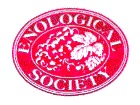 To
get a glimpse of the quality of new wines being released, I judged at this
year’s Enological Society wine competition in Seattle. Focusing on the
entire Pacific Northwest region, it is the region’s oldest with a solid
27-year track record.
To
get a glimpse of the quality of new wines being released, I judged at this
year’s Enological Society wine competition in Seattle. Focusing on the
entire Pacific Northwest region, it is the region’s oldest with a solid
27-year track record.
I am often queried how these competitions
work. Unlike the larger California State Fair, which has dozens of judges
and thousands of wines, this one has only five judges who blind taste each
and every wine in flights by varietal. Wine experts from widely ranging
enological backgrounds are recruited as judges.
International luminaries such as André
Tchelistcheff (the founding father of the California wine industry)
and Dr. Helmut Becker (chief
viticultural researcher at Geisenheim) have participated. I discovered
that ever-affable Dr. Becker, whom I first met at the German Wine Academy
in 1977, was the only judge who refused to spit! Thankfully, there were
fewer wines in those early days!
Judging with me (from left to right) on this year’s panel was Michael Rugers director of wine and spirits at Bern's Steak House (whose cellar features over 7,000 different selections); MaryAnn Graf ex-Simi winemaker and cofounder of Vinquiry; Dr. Gary C. Pavlis Professor of Plant Physiology at Rutgers University; and Lyn Farmer, Senior Editor of The Wine News
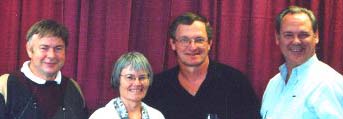
This impressive group with diverse
interests, all residing outside the Pacific Northwest. The reason?
Organizers want judges to evaluate Northwest wines by international
standards thereby ensuring that the winners will have universal
acceptability.
To be eligible for entry, the wine must be
from the Northwest (i.e. Washington, Idaho, Oregon and British Columbia),
available for sale in the State of Washington and must not have been
entered in a previous Festival judging. The latter provision ensures that
the same wine doesn’t wine year after year. Entries are limited to only
200 on a first-come basis with a maximum of three per winery.
This limit means that some potential award-winning wines are not entered. It’s a
problem plaguing all competitions. Wines, which are subject to allocation
due to excess demand, are usually absent. In addition, some high profile
producers don’t enter because they fear their wines may loose
credibility if they do not win awards!
Entering is a no-win situation.
The
panel spends two days evaluating the entries in blind flights. In some
years a Grand
Prize Trophy is awarded if all agree that a single entry is
deserving of special recognition.
We
kicked off at 8:45 am a week ago Thursday with forty Merlots, the largest
group of red varietals. This was an elimination round where only wines,
which might be considered to be potential medal winners, were retained for
subsequent evaluation. Only a few rounds were duplicated meaning that most
of wines were tasted only once limiting the opportunity to check for
bottle variation.
This
first group was, in general, much higher caliber than expected. In fact,
Merlot has been one of Washington’s fastest growing varietals and the
quality appears to be getting better every year. A total of 16 wines or
40% got medals.
Now
that’s not to say that all the judges agreed with one another. As
always, there was some stylistic bickering as to which wines were the
best. This was kept under control by our able taskmaster Gerald Warren.
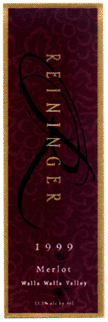 I
originally had three strong Golds in the Merlot class with one falling to
Silver in the taste-off. One thing is certain; the unanimous best Merlot
(with five Golds) and Grand Award
Trophy winner was Reininger
1999 Merlot ($28 US) from the Walla Walla Valley. It’s
unlikely that this wine would have knocked Robert Parker’s socks off
because it was more accessible than weighty! It showed beautifully with
lots of rounded, cedary, ripe red cherry purée flavours. Hopefully the
LCBO will be moved to order some for local wine fans.
I
originally had three strong Golds in the Merlot class with one falling to
Silver in the taste-off. One thing is certain; the unanimous best Merlot
(with five Golds) and Grand Award
Trophy winner was Reininger
1999 Merlot ($28 US) from the Walla Walla Valley. It’s
unlikely that this wine would have knocked Robert Parker’s socks off
because it was more accessible than weighty! It showed beautifully with
lots of rounded, cedary, ripe red cherry purée flavours. Hopefully the
LCBO will be moved to order some for local wine fans.
A
close Gold medal second was the L’Ecole
No 41 1999 Merlot Seven Hills Vineyard
($30 US) also originates from the Walla Walla Valley. It was slightly
minty with chocolaty, ripe red pepper purée flavours. Aspiring winemakers
might note that both these Merlot (the only two Golds in a the field of
forty) were made by punching down the cap by hand during
fermentation thereby maximizing fruit extraction and softening tannins.
See http://www.oregongourmet.com/lecole41winery.html
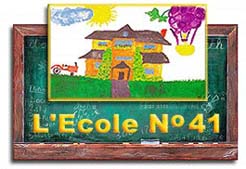 This
year all three of L’Ecole entries got medals. L’Ecole No 41 1999
Semillon
Estate Seven Hills Vineyard
was the only Gold
in the “other white” section. Rounded and ready to enjoy, its
spicy, ripe, apricot purée and butterscotch flavours went on forever on
the palate. It borders on having sex in a glass and is one of three they
produce.
This
year all three of L’Ecole entries got medals. L’Ecole No 41 1999
Semillon
Estate Seven Hills Vineyard
was the only Gold
in the “other white” section. Rounded and ready to enjoy, its
spicy, ripe, apricot purée and butterscotch flavours went on forever on
the palate. It borders on having sex in a glass and is one of three they
produce.
A
third award received by L’Ecole was a Silver for their L’Ecole No 41 1998 Cabernet Sauvignon Walla
Walla Valley. Some 56 cases of this and some 1999 Semillon will
be coming to Ontario via Barrique
Wines at 416-598-0033.
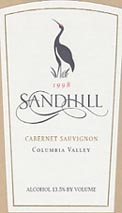
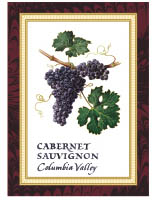 The
other key red contender in this year’s Grand Award run-off was the solid
Gold
medal winning Chateau Ste.
Michelle 1998 Cabernet Sauvignon Cold Creek
Vineyard from
the Columbia Valley (it also tallied up five Golds). It received my
highest score of the group and is beautifully proportioned with fine
vanilla-lime notes. Their 1996 at $43 will be coming our in the Fall Classics Catalogue. Both the LCBO Bayview Village and Queen’s
Quay stores in Toronto have several cases of the mouthfilling Chateau Ste. Michelle 1996 Cabernet Sauvignon Canoe Ridge
Vineyard that was released in Vintages
on May 5th at $32.70. This well made red would be perfect
with a rib eye steak.
The
other key red contender in this year’s Grand Award run-off was the solid
Gold
medal winning Chateau Ste.
Michelle 1998 Cabernet Sauvignon Cold Creek
Vineyard from
the Columbia Valley (it also tallied up five Golds). It received my
highest score of the group and is beautifully proportioned with fine
vanilla-lime notes. Their 1996 at $43 will be coming our in the Fall Classics Catalogue. Both the LCBO Bayview Village and Queen’s
Quay stores in Toronto have several cases of the mouthfilling Chateau Ste. Michelle 1996 Cabernet Sauvignon Canoe Ridge
Vineyard that was released in Vintages
on May 5th at $32.70. This well made red would be perfect
with a rib eye steak.
Of
the 27 Cabernet Sauvignon entries, the only other Gold medal winner was Sandhill
Winery 1998 Cabernet Sauvignon Columbia Valley
with its slightly smoky, cedary, bright baked black cherry
flavours. This small, family owned business specializing in the production
of a single, hand crafted, Bordeaux-styled red. All the grapes are
harvested from their thirteen-year-old vineyard on Red Mountain.
 One
of my personal highest scores Cabernet Sauvignons from the preliminary
round was Russell
Creek 1999 Cabernet Sauvignon Columbia
Valley, which unfortunately didn’t make it into the
finals. Only 350 cases of this unfiltered blend of Cabernet Sauvignon 84%,
Cabernet Franc 8% and Merlot 8% were produced at $28 US.
See http://www.russellcreek-winery.com/
One
of my personal highest scores Cabernet Sauvignons from the preliminary
round was Russell
Creek 1999 Cabernet Sauvignon Columbia
Valley, which unfortunately didn’t make it into the
finals. Only 350 cases of this unfiltered blend of Cabernet Sauvignon 84%,
Cabernet Franc 8% and Merlot 8% were produced at $28 US.
See http://www.russellcreek-winery.com/
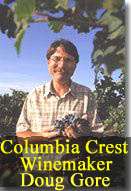 Two
Washington Chardonnays struck gold. Chateau Ste. Michelle 1999 Chardonnay Cold Creek
Vineyard Columbia Valley was rich with ripe lemon-pear flavours
(see http://www.ste-michelle.com/).
The second Gold went to Columbia
Crest 1999 Grand Estates Chardonnay, which was awarded 91
points in the Wine Spectator (May 31st, 2001
issue). There are 350 cases of this Best
Buy coming into Vintages at $18.95 this November. Mark Anthony represents both wineries (905-238-6731). www.columbia-crest.com
Two
Washington Chardonnays struck gold. Chateau Ste. Michelle 1999 Chardonnay Cold Creek
Vineyard Columbia Valley was rich with ripe lemon-pear flavours
(see http://www.ste-michelle.com/).
The second Gold went to Columbia
Crest 1999 Grand Estates Chardonnay, which was awarded 91
points in the Wine Spectator (May 31st, 2001
issue). There are 350 cases of this Best
Buy coming into Vintages at $18.95 this November. Mark Anthony represents both wineries (905-238-6731). www.columbia-crest.com
Of
the twenty Pinot Gris presented, the Gold medal went to the well-priced Firesteed
Cellars 2000 Pinot Gris
My
personal favourite of the group, however, was Elk
Cove 2000 Pinot Gris Willamette
Valley with its bright,
ruby grapefruit flavours (see http://www.elkcove.com/ec_main.html).
It only ended up with a Bronze because this flavour didn’t set
all the judges palates ablaze. Elk Cove is represented by Edward’s
Wines at 416-405-898).
The
amazingly rich, sweet Kiona Vineyards 2000 Chenin Blanc
Icewine from the Yakima Valley was the sole Gold
in the dessert wine class. At $20 US per half, it’s a terrific value
that would rival Canada’s best. It will be presented at a small Red
Mountain appellation seminar in Toronto next month. The agent is Barrique Wines at 416-598-0033.
See http://www.wineriesnorthwest.com/washington/yakima/kiona.htm
Moving
on to the twenty-three Pinot Noirs, I have to admit that my palate was
flagging by the time we reached this group after an overly ambitious lunch
on “Day One” (the Columbia Tower Club is a definite Seattle destination with
terrific views and cuisine). Remember that we kicked off this day with
forty Merlots! Sampled only once, this is one flight I wish I could have
re-tasted with a fresh palate.
There
were three Gold
medal winning Pinot Noirs, but only one captured really my attention - Willamette Valley Vineyards 1998
Pinot Noir Hoodview Vineyard.
It was complex, rich and rounded with an abundance of cherry driven fruit
flavours. See www.wvv.com
For
my palate most of the others seemed to be amazingly restrained, without
the ripe fruit flavours that I was anticipating considering that these
vintages (both 1998 and 1999) have been hailed by most as being sublime. Where
then is the plush fruit? While some may speculate that this is part of the
ups and downs of drinkability that Pinot Noir goes through when it ages, I
think I have another answer.
It
appears that the Oregon producers who diligently reduced their crop to
intensify flavours might have made a mistake in 1998. Why? Given the great
growing conditions, the grapes ripened extremely quickly and may have had
to be picked before the flavours had a chance to fully develop. The
flavour of Pinot Noir is generally “made” in the Fall, which explains
the risky aspect associated with this grape (rainy conditions can
seriously hurt quality). Growers who had more prolific yields (meaning
later ripening) appear to have won the flavour battle.
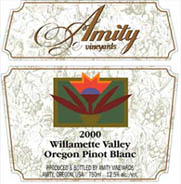 Other
notable reds included a Silver
medal for Preston 2000 Gamay Beaujolais Rosé Columbia Valley,
($10) which I thought, neared rosé perfection (I awarded it a Gold)
~see www.prestonwines.com Just
behind with a Silver was Amity 2000 Gamay
Noir Oregon, which
was not only reasonably priced at $12 US but had all the typicity and
fruit that one might expect from an excellent cru Brouilly! While their
identically priced, delicious, peach-scented Amity
2000 Pinot Blanc Willamette Valley scored a Bronze
(I gave it a high Silver);
it is well worth the price. See www.amityvineyards.com
The agent is Barrique Wines
at 416-598-0033.
Other
notable reds included a Silver
medal for Preston 2000 Gamay Beaujolais Rosé Columbia Valley,
($10) which I thought, neared rosé perfection (I awarded it a Gold)
~see www.prestonwines.com Just
behind with a Silver was Amity 2000 Gamay
Noir Oregon, which
was not only reasonably priced at $12 US but had all the typicity and
fruit that one might expect from an excellent cru Brouilly! While their
identically priced, delicious, peach-scented Amity
2000 Pinot Blanc Willamette Valley scored a Bronze
(I gave it a high Silver);
it is well worth the price. See www.amityvineyards.com
The agent is Barrique Wines
at 416-598-0033.
I had the pleasure of tasting the Amity 2000 Pinot Blanc Willamette Valley again at the sublime The Herbfarm restaurant in Woodinville (just 20 miles from Seattle) the day after the competition and it proved to be a divine match for their corn soup with chanterelles, coral mushrooms, smoked mussels and basil. A full review of this restaurant will be appearing later this month on our Vintage Destinations website. Fortunately, LCBO’s Vintages has just ordered some for a future listing. www.theherbfarm.com
Myron
Redford of Amity has this to say about Pinot Blanc: Much
of the wine in America labeled "Pinot blanc" is not the real
thing. In particular most of the "Pinot Blanc" from California
is actually Melon de Bourgogne, the variety used for Muscadet in France. This
misnaming is not a cruel plot, but a mix up that occurred in the 1960's
and 1970's at the University of California at Davis. They had true Pinot
Blanc at one time, but the inadvertently discarded it, keeping Melon
(which has a very similar leaf shape) thinking it was Pinot Blanc. For
over three decades, growers ordering "Pinot Blanc" were sent
Melon and told it was Pinot Blanc.
What
is being done to end the confusion? So far, the B.A.T.F. (the agency of
the federal government responsible for wine labeling) has been unwilling
to become involved in the issue. However, Oregon's labeling regulations
require that wines labeled with a varietal name truly come from that
variety. Thus, in Oregon, wines made from Melon may not be labeled
"Pinot Blanc". So if it says Pinot Blanc, and it's made in
Oregon, it is Pinot Blanc. With more true Pinot Blanc coming to the
marketplace, it will be important to clearly differentiate true Pinot
Blanc from other wines carrying that name.
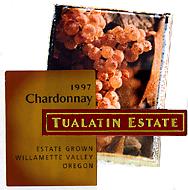 Moving
on to the Silver
medal winning Tualatin
2000 Semi-Sparkling Muscat ($15), here’s a wine to challenge
the best Moscato from Asti.
This delicious, sweet, low-alcohol, effervescent crows pleaser is perfect
for a Sunday brunch.
Moving
on to the Silver
medal winning Tualatin
2000 Semi-Sparkling Muscat ($15), here’s a wine to challenge
the best Moscato from Asti.
This delicious, sweet, low-alcohol, effervescent crows pleaser is perfect
for a Sunday brunch.
 Last
but not least, there is Syrah,
which I feel has a terrific potential in Washington. The Gold medal-winner
Kestrel Vintners 1999 Syrah Yakima
Valley ($28 US) had terrific, ripe, fresh beefsteak tomato and
roasted cherry flavours with sublime rounded tannins and some earthy notes
on the long lingering finish. See http://www.kestrelwines.com/
I scored three other Syrah with silvers and they are highlighted on the
results sheet, including a Best Buy Hogue 1999 Vineyard Selection Syrah Columbia Valley
at only $18 US ~ see http://www.hogue-cellars.com/.
These wines are now represented by Atlas
Wines at 905-564-6900.
Last
but not least, there is Syrah,
which I feel has a terrific potential in Washington. The Gold medal-winner
Kestrel Vintners 1999 Syrah Yakima
Valley ($28 US) had terrific, ripe, fresh beefsteak tomato and
roasted cherry flavours with sublime rounded tannins and some earthy notes
on the long lingering finish. See http://www.kestrelwines.com/
I scored three other Syrah with silvers and they are highlighted on the
results sheet, including a Best Buy Hogue 1999 Vineyard Selection Syrah Columbia Valley
at only $18 US ~ see http://www.hogue-cellars.com/.
These wines are now represented by Atlas
Wines at 905-564-6900.
Full details on all 132 winners (along with some of my personal highlights) are posted below. .Click Here To See The Results. While there definitely is gold in the Pacific Northwest, the high US dollar combined with rising export prices seem to have put a damper on local sales. But who knows, maybe Vincor will be able to get us a deal on Hogue wines.
Copyright Food & Beverage Testing Institute of Canada
2004
Prior written permission is required for any form of reproduction
(electronic or other wise) and or quotation.
Contact Michael Vaughan at
mbv@total.net
